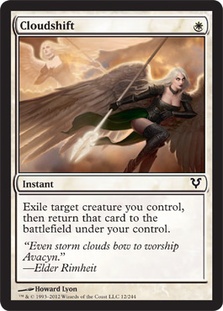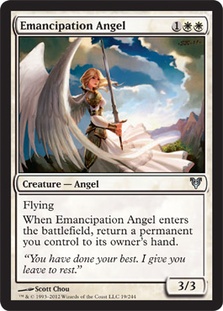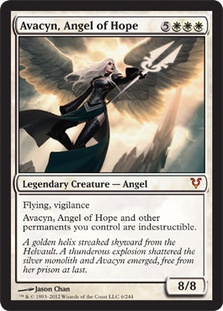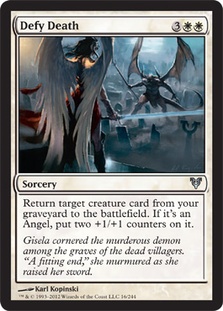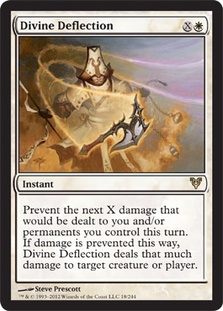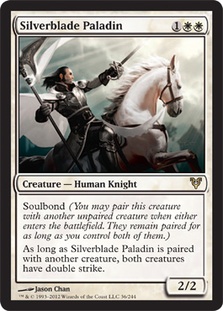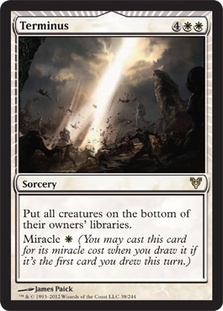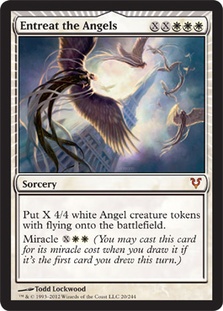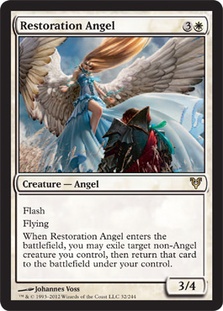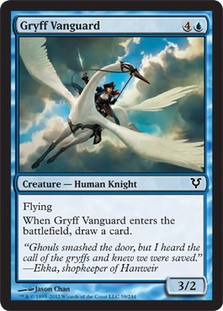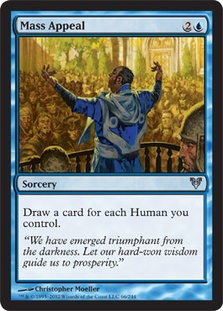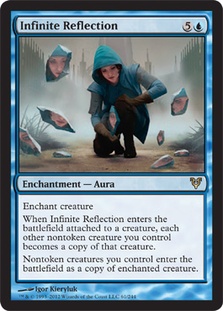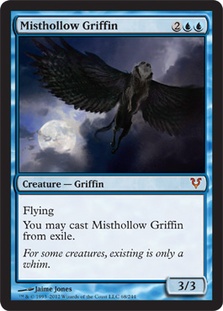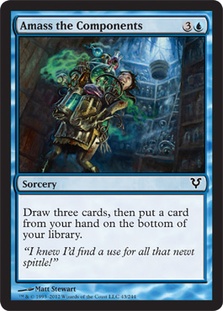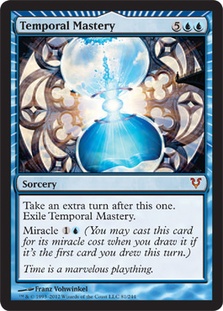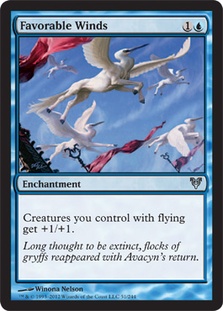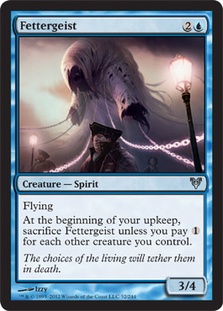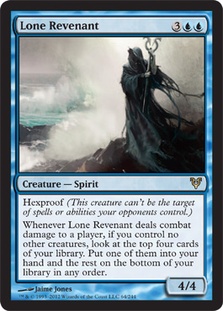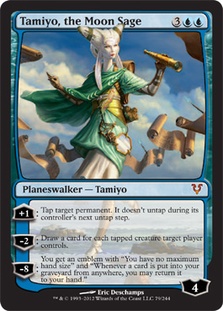Avacyn Restored is here, complete with Angels, Demons, miracles, and some pretty wicked lands. Innistrad and Dark Ascension have been no joke in Constructed, and Avacyn Restored is shaping up to be a worthy conclusion to the block. Wizards of the Coast is clearly continuing their theme of pushing cards that are good in new ways, looking to expand Standard even further. They are also continuing their theme of making sweet cards good (Angels, Dragons, miracle comebacks). This is in stark contrast to 18 years ago, when learning that “Dragons, Nightmares, and Force of Nature are terrible and hurting yourself is the best thing you can do,” was one of the pillars of cutting edge card evaluation.
It’s not that evaluating cards was easy in those days, nor is it somehow magically easy now. After all, there isn’t a one to one correlation between sweet cards and card power. Even if there was, one does not just put the ten best cards together, call it a deck, and win (unless one is Michael J. Flores). Additionally, there’s a definite subjective element to what makes a card “sweet.” And it’s not just a matter of knowing which cards are above average. There’s a lot of room between the sevens and nines, if you know what I mean.
Speaking of rating cards, long time readers will remember that I’m not keen on rating cards one to ten or one to five during set reviews, as the number is extremely misleading and often does more harm than good. If our goal is to understand every card, assigning numerical values is an extremely quick way to close our minds. Even just reading about someone giving a card the label of “bad” closes our minds to it. This obviously varies from person to person, and some actually thrive on and seek out the “bad” cards to prove people wrong. That said, a shockingly high number of really “good” cards get labeled bad when new sets are released because people are just concerned with assigning labels.
What does that number even tell you? How obvious the card’s use was to the person giving it the label? This is a dangerous road that helps magnify the information cascade that cause Magic’s metagame to become very inbred at times and overly reliant on the 1%. For those not familiar, the 1% rule is the observation that 1% of people on the Internet produce most of the original content, 9% edit or modify that content, and 90% lurk without contributing.
Did you think deckbuilding moving in this direction was a phenomenon unique to Magic?
This is similar and related to the Pareto Principle , which is that for many, many events, 80% of the effect comes from 20% of the causes. It’s not that 80% is some hard fast number in all events, and in fact can vary anywhere between 50% and 100%. It does observe, however, that a shocking number of events in life ranging from making money to how many peas appear in pods in gardens continually occur in nearly this exact ratio.
This is all well and interesting, but how it applies to Magic is that buying into number ratings for cards has a subtle influence on us that causes us to decide “that card is a good one,” or “that card is for Limited,” or “that card is unplayable.” These can be great short cuts at the proper times but are not always useful for gaining the greatest understanding of a new set. The more people that fall into these traps, the more reliant the majority become on those that are figuring out how to actually use each card.
Today, I’d like to talk about the white and the blue cards (though I am saving the gold cards for when covering green, artifacts, and land on Friday). In particular, I’d like to talk about ten of the white cards that most interest me from a Constructed standpoint as well as the top ten blue cards that interest me. While there’s a definite bias for intrinsic power level (and my snap assessment), this is ranking of my personal interest in working with these cards.Â
There are more sweet cards than there’s room for (as this set is deeper than average). Whichever cards we cover that you were already interested in, great, more material to work with. Whichever cards we cover that you weren’t thinking about, maybe it’s worth slowing for a moment and reflecting on them. Any cards I didn’t cover that you were interested in, use them!Â
For instance, I could tell you Bower Passage is probably not very good because making your creates unblockable is already generally not highly valued in Constructed and making your creatures only unblockable by fliers is a much smaller subset of that ability. Spending a card and two mana to do this is generally not nearly as valuable as just using a card like Corrosive Gale if you’re in the market to make fliers not able to block your guys.
Of course, what does that do? It shuts down. It stops the flow of ideas. What if making your fliers unblockable is actually good? Corrosive Gale doesn’t do that. What if lots of people rely on fliers to play defense, using cards like Favorable Winds to power up their Lingering Souls? It’s more likely than not not going to work out to be that good, but if it is it might be brilliant to play it.
So today we’re focusing on how to use these cards, but the master deckbuilder seeks to understand all of the cards. When looking at the spoiler, try experimenting with, “How can I use this card to gain an advantage?” And remember, this is definitely a form of the paperclip game. Divergent thinking isn’t about figuring out what the most popular answer is going to be Family Feud style. It’s about coming up with 200 ways to use the paper clip, many of which seem crazy.
White
10. Cloudshift – How good is a Momentary Blink that you can’t flashback? Well, on balance, it does cost just a single mana instead of two. How good is flashback of four? Well, how does Call of the Herd compare to Watchwolf? They’re obviously quite different. Besides, Watchwolf and Call of the Herd are proactive and about the influence over the board. A card like Think Twice is obviously much less exciting if it costs one and doesn’t have flashback. Where does Cloudshift fall on this spectrum?
Cloudshift can save your creature from spot removal, give you an extra chump blocker, save an attacker that was going to die in combat (like a Geist of Saint Traft), and most importantly (from a deckbuilding standpoint) can reset your enters the battlefield triggers. Snapcaster Mage is the first one that comes to mind, not surprisingly, and almost single-handedly assures that Cloudshift will seem at least some play. Being able to save your creature is a situationally powerful ability, and getting a chance to cash it in for a Relearn can be quite valuable. Additionally, if you play more “when enters the battlefield triggers” (which Cloudshift suggests), your Snapcaster Mage becomes more powerful since you can Snapcast an earlier Cloudshift to reset your Huntmaster, your Strangleroot Geist, or your Blade Splicer.
What I imagine will hold back Cloudshift is that there is a subtle but monumental difference between Momentary Blink and Cloudshift. When Momentary Blink was legal, so were Mulldrifter, Reveillark, Venser, Riftwing Cloudskate, and more. If those cards were all legal today, Cloudshift would have more weight, just as if Cloudshift was legal then it would be great. Drawing one card from Gryff Vanguard is just not the same as drawing two from Mulldrifter (especially factoring in only having to evoke it). Additionally, Restoration Angel does what Cloudshift does only better (save some Snapcaster shenanigans).
9. Emancipation Angel – Overshadowed by Restoration Angel but still a possible sleeper. Three mana for a 3/3 flier is at least worth talking about, so the question becomes is Gating a drawback or a special ability? Resetting your 187s is the main plan, most likely, but you can just bounce your own land.
What kind of a deck do I see this going in? There are a number of different avenues to explore. First of all, he’s yet another great flier for some kind of a Favorable Winds deck. You’re generally not going to get such a great rate on your three-drop.Â
You could easily pair him with Restoration Angel and just play some kind of midrangey creature deck that only Brian Kibler is likely to ever build optimally. Both Restoration Angel and Emancipation Angel seem to buff Blade Splicer quite a bit, an interesting observation if you’re the type that trades cards.
Perhaps he ends up as a modest three-drop in some sort of White Weenie deck with Blade Splicer, Champion of the Parish, maybe even Elite Inquisitor to synergize with. It’s too bad no one plays with any sort of Pacifism these days…
8. Avacyn, Angel of Hope – Let’s just rip off the Band-Aid. Avacyn isn’t as good as Griselbrand.
Ok, now that we have that out of the way, let’s evaluate what she is. Eight mana is an awful lot: what impact does she have on the board? Well, the closest comparisons would seem to be Iona, Shield of Emeria and Simic Skyswallower (which she falls halfway between).
She doesn’t have nearly the impact on the game that Iona does; so much less in fact, I would argue she’s at least two mana less impact than Iona. What about Simic Skyswallower? Well, he’s a relic from an earlier era and would likely not be good, these days. In fact Sigarda, Host of Herons is very nearly the same amount of impact on the board as a Simic Skyswallower but costs two mana less.
So how good is Avacyn? Well, if you’re talking about cheating her into play such as with Unburial Rites, you have to ask yourself why she’s not just Griselbrand or Elesh Norn. One major advantage she does have is that she’s a lot more durable than either Griselbrand or Elesh Norn. While those two creatures have such an immediate impact (drawing seven cards or Wrathing the opponent’s side of the board), she’s the one that can actually live through a Go for the Throat or Day of Judgment. Eight power is definitely a big game as well, and her ability to make your other creatures indestructible gives her other tactical advantages.
Another possibility is our number seven card, Defy Death…
7. Defy Death – While generally not as strong as Unburial Rites, Defy Death does have a number of applications, and it’s very possible to just want more than four reanimation spells. What if you aren’t playing black? What if you want to Reanimate Angels?
My first guess is that the most common way to use Defy Death is just as a one- or two-of in someone’s dedicated Reanimator deck. You could definitely play more, but between all those fatties and all these reanimation spells, we’re talking about a lot of expensive action.
I do wonder if it’s possible to play a dedicated Angel deck? It’s kind of a weird tribe to build around, but you do get Defy Death, Seraph Sanctuary, Scroll of Avacyn, and I guess Herald of War(?).
6. Divine Deflection – The latest in a long line of Shining Shoals, Harm’s Ways, and the like, here are the basics with Divine Deflection:
-It protects your creatures from red sweepers, meaning a Divine Deflection for three saves three Mirran Crusaders from Whipflare.
-It protects your planeswalkers (unlike Harm’s Way for instance).
-It gives a white deck reach (as it’s a source of direct damage).
-If the only target leaves play, the spell fizzles (so if they Go for the Throat of their Geralf’s Messenger, you’re not going to be able to redirect the next six damage like you were going to).
-It’s probably not as good as Shining Shoal, but there’s a lot of room for a card to be worse than Shining Shoal and still be good (and in many, many circumstances, better).
-Most people will underestimate this card, since people always underestimate this kind of card. People have not exactly been conditioned to think highly of damage prevention/redirection.
While it would be easy to play too many tricks in our white aggro decks, a well-placed Divine Deflection can open up several new dimensions and is well worth exploring. Considering playing White Weenie? WWWD?
What Would Wescoe Do?
(Rietzl! Where are you? Are you going to just sit there and let this man walk off with the White Weenie crown? Then again, when Paulo and Luis play White Weenie more than you do…)
5. Angel of Jubilation – My preview card discussed at length here , Angel of Jubilation is something of a cross between Hellrider and Ajani Goldmane. It may be fragile, but it does have a massive impact on the game and can completely take over if unchecked. It has a lot of competition with Hero of Bladehold and Restoration Angel (not to mention Sorin or other colors), however it may prove to be the mono-white four-drop of choice when Hero rotates. Even before that, however, it has a very important feature that may bring it into the spotlight immediately.Â
It stops Birthing Pod, Dismember, Corrosive Gale, and Griselbrand.
Birthing Pod is probably the most important ability shut down by Angel of Jubilation’s “no sacrificing guys and no paying life” clause, as Birthing Pod has already skyrocketed back into the spotlight as a result of Strangleroot Geist. Restoration Angel is likely to continue this trend, as it’s such a powerful new weapon for a strategy that’s already been getting richer.
Dismember has fallen out of favor as of late but would otherwise be a great weapon for combating this new surge of big butt creatures like Restoration Angel. Corrosive Gale, on the other hand, is a great hate option that’s looking better than ever. If you can produce green mana, no problem, but a lot of people want this effect in their black, blue, or white decks…
Griselbrand may seem a strange one to hose, but he’s so off the charts we may come to value the ability to shut down our opponents that build a “Bargain” more than we would expect.
4. Silverblade Paladin – A soulbond creature? What is this? I thought this mechanic was for Limited only! In general, Soulbond does lend itself well to formats without a lot of removal (such as Avacyn Restored Limited), however, Silverblade Paladin has such a huge impact on the board he’s certain to cross over into 60-card formats. As we know from Mirran Crusader, a 2/2 double striker for three can do some serious damage. Once you factor in his ability to give another creature double strike “with haste,” you’re talking about a major threat. For more on Silverblade Paladin specifically, check here .
3. Terminus – The top three white cards are all home runs. In most sets Terminus would take the top spot, but this is a strong set. I break down Terminus in detail here , but the long and the short of it is that Hallowed Burial is more exciting than Day of Judgment at the moment (a card that’s not that exciting). Costing one more than Hallowed Burial isn’t a bad deal, so even the downside of Terminus isn’t bad. The ability to save a ton of mana when you miracle it can lead to some real momentum swings, allowing you to sweep the board and drop a planeswalker in the same turn.
Miracles have an extremely variable power level, but so many of them being good make looting like Faithless Looting and especially Desolate Lighthouse extremely good. Even casting cost aside, Hallowed Burial is extremely good sometimes and totally dead other times. This makes it the perfect card for a deck with a lot of looting (to be able to get rid of it when it’s bad).
2. Entreat the Angels – Again, all three of these top slots are very serious candidates for best card in the set. This set is definitely white’s day to shine. Entreat the Angels is discussed at length here but can be basically summed up like this:
-When you miracle it, you will often be able to win the game single-handedly from it.
-You’re going to get stuck not miracling it more than most miracles (as it costs so much).
-When you do get stuck with it not miracled, it’s still nearly a Serra Angel / Broodmate Dragon split card.
-It’s so powerful it’s going to greatly influence deckbuilding decisions, such as an increase in the number of Sever the Bloodlines and the return of Corrosive Gale (a card that seems poised to make a comeback).
Entreat is likely to become a premier finisher capable of taking over games on its own, generating card advantage or comebacks, and possibly leading to a return of white-based control decks. Its mana requirement is no joke, but the mana fixing in Standard is very decent at the moment.
1. Restoration Angel – Yet another card discussed at length in an earlier article (here ). White is just killing it in Avacyn Restored. Restoration Angel isn’t quite as appealing to me as Entreat the Angels, however, it’s likely to win even more as this card’s rate is just through the roof.
A 3/4 flier for four is already an aggressive rate and would be a great first pick in Draft. Add flash and we have fringe Constructed chances. Add the ability to Cloudshift a non-Angel creature and you’re talking about very nearly adding “draw a card” to the text (in a similar fashion to Cryptic Command, Bloodbraid Elf, Snapcaster Mage, and Lingering Souls). I don’t have Restoration Angel leading that class, but that’s the class it’s in and that alone is very scary.
Resetting Huntmasters, Blade Splicers, persist creatures, and Snapcasters is the top order of business, but even just saving creatures in combat can be huge. It’s important to remember that a weakness of tokens is that they cannot be saved by Restoration Angel or Cloudshift.
Another interesting twist to consider is that this new flash creature at such a pushy and exciting rate means we’re going to be seeing a lot more flashing down of creatures and blocking than we have in a while. This changes what kinds of cards are good, such as Giant Growths. For instance, if you play a 3/4 on your main phase and I attack with my 3/2 Strangleroot Geist, you can be reasonably certain I have something (or at least am up to something). However, if you flash down your 3/4 in combat, it’s pretty safe to assume that you’ve “gotten” me. Since your mana is tapped from playing the flash creature and it generally always makes sense for you to block here, this makes my Giant Growth extremely effective, giving me a strong tempo play.
I’m not talking Giant Growth itself, or even necessarily +N/+N tricks. I’m just talking about tricks in general, since tricks are best when it makes sense for your opponent to walk into them and flash creatures make this true far more often.
This is somewhat related to the “special ability” of cards like Bloodcrazed Neonate. Because Bloodcrazed Neonate must attack, your opponent will not think it’s strange when you attack with your two Neonates into their two 4/4s. This makes Vampiric Fury actually work as a trick. If the Neonates did not have to attack, your opponent would be unlikely to block both this way as you would surely have to be up to something.
I don’t know what trick is going to shine as a result of Restoration Angel being so good, but there’s a good chance at least one will.
White:
10. Cloudshift
9. Avacyn, Angel of Hope
8. Defy Death
7. Divine Deflection
6. Emancipation Angel
5. Angel of Jubilation
4. Silverblade Paladin
3. Terminus
2. Entreat the Angels
1. Restoration Angel
Blue
While not nearly as exciting as white, blue does offer a number of potent new tools, many of which are being underestimated at large. This isn’t an uncommon experience with new blue cards, though it’s important to remember that by the time Avacyn Restored was developed, Wizards had realized that Snapcaster Mage was a little too pushy (and was just realizing the implications of Delver of Secrets).
10. Gryff Vanguard – Yes, I realize I have a problem.
Let me just leave this here and continue to enjoy the fantasy world I live in that completely denies the harsh reality that Mulldrifter left us and isn’t coming back.
9. Mass Appeal – Distant Melody was always a fairly underrated Constructed card in its day (except by Alan Comer), and Mass Appeal is actually better (albeit more narrow). Humans is a very reasonable type to want to name, as there are tons of good Humans and incentives to play them. Is drawing some extra cards really what those decks want to be doing? Not really, but they could certainly be persuaded if the rate was good enough. It’s not a very unrealistic draw at all to open with turn 1 Delver/Champion/Doomed Traveler, turn 2 Gather the Townsfolk, turn 3 Mass Appeal. Turn 4 Mass Appeals will be even more common, and this is an excellent way to punish someone with a sweeper (rather than overcommit). Additionally, W/U Human decks often struggle to find enough good Snapcaster targets. Mass Appeal is a potentially top-notch one.
8. Infinite Reflection — It’s very difficult to figure out what to do with this card, but it costs six instead of four or five, which makes me suspect that someone in WotC found something to do with it. Generally whenever people use cards like this (Splinter Twin, Hive Mind, Mirrorweave), they win the game. As such, even at six I’m very interested. If you crack the code, let me know. Even though they’re pretty wretched 65% of the time, it’s crazy to underestimate these kinds of cards.
7. Misthollow Griffin – Obviously quite cute in Limited, as a 3/3 flier for four that forms a mondo combo with your Crypt Keeper, this guy has some pretty exciting applications in Constructed. What if you combine him with Relic of Progenitus and just build your own Cheaty Face? There are tons of ways to easily exile cards repeatedly in Modern (though it’s not clear if it’s easy or not in Standard). Is a 3/3 flier that never really dies good enough? I know it sounds hot for Standard, if that’s a realistic option. Is it realistic to play Memoricide and just plan on giving yourself a Lobotomy?
You could Memoricide the opponent when tactically relevant. Then, when the time is right, point that bad boy at your dome. It’s like a draw four! Granted, all you draw are Phantom Monsters, but if you like Squadron Hawk, this might be something you could get into. If you have a good engine in your deck for continuing to exile cards, this could become scary in a hurry. After all, it’s not that drawing Memoricide plus Misthollow Griffin is a combo since you actually only need to draw the Memoricide half.
6. Amass the Components – What has it come to that Sift is so highly prized? Even worse, this is a Sift with a drawback. We didn’t know how good we had it! Sift would let us set up jerk face Reanimator combos. Amass the Components is a lot more about playing fair. That said, we don’t exactly have nice things like Concentrate, Deep Analysis, or Fact or Fiction. Sift is pretty close to a draw three, especially when you factor in all the sweet miracles that we would love to put back into our deck for later (instead of rotting in our hand).
This isn’t the type of card that we’re always supposed to play four copies of or anything like that, so don’t be afraid to experiment with just sticking a couple copies in the right places. There’s a lot of competition at four, five, and six, but card draw is also highly in demand. This isn’t an exciting rate, but it’s what we’re looking for.
5. Temporal Mastery – Talk about a puzzle that looks sexier than it really is. Time Walk is such a prized ideal in Magic that it starts to seem like an end in and of itself. Taking an extra turn is not game over. It isn’t even always as good as Divination.Â
Temporal Mastery is actually good (in much the same way Time Warp was actually good), at least when it comes to Standard. Is it broken in Legacy?Â
Who cares?
I’m sorry. Did I say that out loud? What I meant was, “It might be ok, it’s going to excite some people, and if it’s too good it’s going to bring things to a head with the format.”
A conspiracy theorist might conclude that Temporal Mastery is the latest poison created by WotC to try to get people to abandon Legacy in favor of Modern. Mental Misstep? Snapcaster Mage? Delver of Secrets? Yeah, Brainstorm has quite the lobby, but the right disaster at the right time can go a long way towards manipulating the masses into accepting some pretty outrageous demands (for the “greater good”).
Maybe Brainstorm survives this one. Maybe Temporal Mastery isn’t the one that ends The Game. However, if it isn’t this one, it will be the next one or the one after that. Eventually, someone is coming for your Brainstorms. They will be wearing a smile and talking somberly about the safety of the format.
When Brainstorm is banned, the format will go the way of Vintage (or so the theory goes…). Want to do your part to postpone that inevitability? Keep putting up good finishes with Maverick. Keep Affinity in the discussion. Play less combo decks. Advocate Temporal Mastery be banned (if it comes to that, which it probably won’t). It’s important to pretend in the public that Legacy doesn’t need Brainstorm, but always, always vote as though it does.
4. Favorable Winds – Would anyone be as excited about this card if Intangible Virtue hadn’t been banned? They aren’t even for the same deck and Intangible Virtue isn’t even banned outside of Block. Still, there’s a real hole in the two-spot of the various Drogskol Captain decks. Is Favorable Winds going to find a home in some sort of U/W/B Spirits deck ala Black/Finkel/GerryT?
Probably.
3. Fettergeist – Speaking of sweet fliers, this is a Serendib I can really get behind (and is generally better, in my opinion). There was once a day when Steel Golem was a tier 1 Constructed creature in blue decks. Fettergeist is like a Steel Golem except it flies and instead of not being able to play more creatures, you can (they just cost one mana a turn).Â
Where Fettergeist is particularly exciting is as a blocker for creatures like Strangleroot Geist and Hellrider and in formats where burn spells deal three or less. This artwork is pretty sweet, but the Arabian Serendib did set a pretty unobtainable bar. Still, the rate on this one is significantly above the norm, and even though these types haven’t been good in a while (yes, they really did use to be good), that completely fits WotC’s MO of which cards to make good:
A) Cards that are sweet (like Serendib).
B) Cards that are not the type that has been good recently (like Serendib).
Look, I don’t want to hear this revisionist history that Serendib was never good. He won the only Vintage Pro Tour (So, scoreboard)!
Remember when Baneslayer Angel was printed? That type of card is never good…
…Of course, it’s a fine line between Baneslayer Angel and Phyrexian Obliterator.
2. Lone Revenant – Sleeper of the set, a hexproof 4/4 for five is at least interesting, and the ability to Impulse every time he connects ends games in the way Sphinx of Jwar Isle never could. He doesn’t fly, a major strike to be sure, but he has an extremely durable body that cannot be ignored (unlike Sigarda, Host of Herons). Once Lone Revenant hits you, what do you imagine your chances of getting out of it next turn to be?
1. Tamiyo, the Moon Sage – This chick is the real deal. As always, she’s a planeswalker, so her $845 price tag may be a tad hype-inflated. However, she really is a top-notch Constructed card and will see play for years. She:
-is versatile.
-takes over games.
-has a defensive ability.
-has an ultimate that’s pretty nearly game-over.
-is fun.
-is better than Jace Memory Adept (in general).
Where do I imagine her going? Every non-aggro blue deck could be potentially interested in a little Tamiyo action, which includes U/B Control, Esper Walkers, Grixis, U/W Control, new U/R and many color control decks, and so on. Additionally, it’s going to appear in some aggressive decks (and not always just the sideboard). For instance, it has very real chances of making an impact on Delver decks, as well as some new breed of midrange creature deck to come. Additionally, it’s looking promising to be a defining card in Block Constructed.
Her ability to tap the target she’s going to lock down (an improvement over Ajani Vengeant) makes her a very potent threat in decks that can actually attack. Her ability to draw a ton of cards against aggression can totally take over creature vs. creature matchups. While she’s merely so powerful that control decks will use her, her abilities are deceptively aggressive and like Ajani Vengeant, will show up in decks that are mostly creatures quite a bit.
I think a lot of people are hedging on Tamiyo, suggesting she’s merely going to be decent (like almost all planeswalkers are). It’s impossible to know for sure without getting some experience with her, but just evaluating her abilities and costs in theory, I think she has good chances to be in the top 3 planeswalkers in the format.
Blue:
10. Gryff Vanguard
9. Mass Appeal
8. Infinite Reflection
7. Misthollow Griffin
6. Amass the Components
5. Temporal Mastery
4. Favorable Winds
3. Fettergeist
2. Lone Revenant
1. Tamiyo, the Moon Sage
Thanks for joining me today. I’ll be back on Wednesday and Friday as we continue to explore what all is in the Helvault.Â
This is your chance to lock it in and show off your superior card evaluation skills! What was the biggest, most important card I missed from each color? What card are you going to look back on two months from now and laugh that you saw coming and others didn’t? Also, what card did I overrate the most in each color?
See you Wednesday!
Patrick Chapin
“The Innovator”

